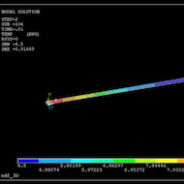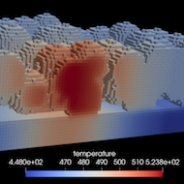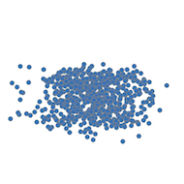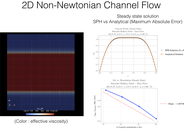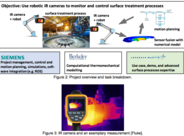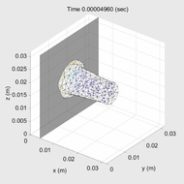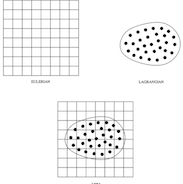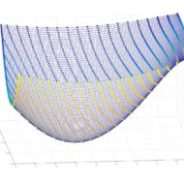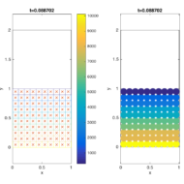Creation of 3D Custom ANSYS Elements for Studying the Multi-Physics of Quench Prevention in Superconducting Magnets
Research by: Kate Edwards Figure: Nodal temperature values for a quench propagation test using the 3D Custom ANSYS Thermal Element. Quench is a failure of a superconducting magnet where the superconducting material returns to a resistive state due. This occurs when the material reaches either its critical current, magnetic field, or temperature due to large magnetic fields or defects in the magnet. Local quenches cause a chain reaction throughout the magnet, rapidly causing the entire coil to become resistive – potentially leading to fatal damages to the magnet. Therefore, quench protection is often built into the magnet. Many different quench protection systems exist, and it is important to understand how they will react to a quench and how well they can protect the magnet. To better understand and design these systems, computational simulations become an important tool. ANSYS includes the capability for users to create their own element with code that defines the element’s properties and the generation of its finite element matrices. After compiling the element with ANSYS, all other aspects of the software – including geometry and mesh generation, solving, and post-processing – are compatible with the element. Two dimensional elements – one thermal and one electromagnetic – have already been developed, extending the capabilities for simulation of superconducting magnets to include the effects of interfilament coupling currants, quench, and temperature and magnetic field dependent properties. They can also be coupled with each other using the ANSYS Multi-field solver [1]. My project involves developing similar thermal and electromagnetic elements in 3D, as well as updating both dimensions to include a surface heat flux load and additional material property options. Modeling superconductors in three dimensions allows for more accurate modeling of the winding superconducting coil and can capture unsymmetric phenomenon. [1] L. Brouwer, D. Arbelaez, B. Auchmann, L. Bortot, and E. Stubberud, “User Defined Elements in ANSYS for 2D Multiphysics Modeling of Superconducting Magnets,” 2019, submitted to Superconductor Science and...
read moreUncertainty Quantification of Material Thermal Responses due to Perturbations of Laser Power for Selective Laser Sintering (SLS) Processing
Research by: Nicolas Castrillon A widespread use of lasers in AM is to induce a given temperature and a phase transformation in materials deposited onto a substrate. For a laser to induce a phase transformation in the material, the power intensity must be sufficiently high to induce melting and, in all cases, stay below a vaporization or burn-off temperature of the target material. Oftentimes, there is variability in the laser input power to the target zone. For a process designer, a central question is to determine the uncertainty of the resulting material properties, i.e. temperature and state (solid or melted), due to uncertainty in the energy (laser) input. This motivates the present work, which integrates relatively fundamental heat transfer models that describe the thermal effects due to (a) laser irradiation, (b) heat conduction into the surface of deposition, (c) black-body infrared radiation outwards into the surroundings, (d) convection due to an exhaust apparatus to control the cooling of the system, and (e) phase transformations. This thermal framework solves the 3D heat equation for a randomly-deposited polymeric powder particles embedded in a matrix, in this case air, which gives the domain spatially heterogeneous material properties. The domain is voxelized and a finite difference method employed to resolve the material temperatures at each voxel. It is important to note that the voxel grid is fine enough to capture the contours of the particle-air transitions. Finally, the temperatures are integrated to a desired final simulation time. Next steps involve defining a metric for quantifying the spatial uncertainty of the melt pool contour from perturbations of the laser power setting. Multiple cases will be run to define a response surface and achieve a reduced order model that will yield fast simulations of thermal...
read moreModeling and simulation of SLS-3D printing process
Research by: Timo Schmidt More than 50% of the raw materials handled in industry appear in particulate form, which is why an optimal powder might be of interest for industry. However, it is obvious that optimal needs to be defined for each application in a different way. This research project is focused on the SLS-3D printing process, where repeatedly layers of particles are created and sapped by a laser to create the final product. A Discrete Element Method is used to analyze the behavior of the particles in the layer. Moreover, the impact on the density of particles per volume depending on the friction and damping properties of the particles is...
read moreSmoothed Particle Hydrodynamics for Multiphysics Simulations
Research by: Chang Yoon Park Smoothed Particle Hydrodynamics provides a way to approximate field derivatives with a set of unstructured points. Due to its simplicity and ease of implementation, it has gained great traction for solving problems related to free-surface fluid flows. Unfortunately, due to several drawbacks of the conventional/traditional SPH formulations, it was never a massively popular choice for solving solid mechanics problems / non-newtonian fluid flow problems. To overcome the previous difficulties researchers have been facing when using SPH for such problems, I am developing new approaches based on total lagrangian SPH formulations and implicit time stepping schemes. These numerical methods can then be used as a framework simulate various additive-manufacturing situations, such as direct-ink-writing...
read moreParticle Method for Simulation of Selective Laser Sintering Process
Research by: Roger Isied Picture from: A coupled discrete element-finite difference model of selective laser sintering–Rishi Ganeriwala and Tarek I. Zohdi Selective Laser Sintering (SLS) and Selective Laser Melting (SLM) are emerging as popular additive manufacturing processes due to their ability to create custom geometries in a vast range of materials such as polymers, composites, and most notably, metals. These processes work by repeatedly depositing a layer of material powder onto a print bed and utilizing a laser to either sinter or melt the layer of particles in a selected region such that it forms the cross-section of the desired geometry. While it provides much functionality, it is currently limited due to large defects that are frequent and inconsistent in even simple geometries. Furthermore, parts fabricated from this process almost always require some form of post processing to address macro and microscope defects and to create features that were not feasible with the SLS/SLM process. Understanding how the controllable parameters of this process can be optimized is essential for the industry to better trust this versatile manufacturing process for a wider scale of applications. This can be done through numerical simulation of these manufacturing processes. This dynamic and multiphysics nature of this process cannot be modeled using standard FEM packages as it would be too computationally expensive. I am focused on discretizing the manufacturing process into each of its physical parameters through the use of meshless particle-based methods such as the Discrete Element Method. In doing so, I can begin modeling this process by implementing a kinematic simulation of the deposition of the particles as well as a thermodynamic simulation of their heating by lasers. Moving forward, I hope to model other aspects of the process such as the laser physics and the effect of geometry on subsequent layer...
read moreThermomechanical Simulation for Robotic IR Camera Monitoring of Thermomechanical Surface Processes
Research by: Donghoon Kim, Youngkyu Kim, David Alcantara Many surface treatment processes involve some sort of energy transfer to the treated part. This transfer can cause thermal stresses due to temperature gradients and ultimately deteriorate the treated part. To reduce the effects from energy deposition, it is necessary to monitor the state of the part which is nontrivial due to “hidden” states that cannot be monitored, such as internal temperatures and thermal stresses. The project aims to couple an IR camera reading the part’s surface temperature with thermomechanical simulation to infer the hidden states. Ultimately, the simulation’s output will be used to determine where the camera should be repositioned for more accurate state computation. Thus, the simulation must be performed in real time to keep up with incoming IR camera data. A multitude of simulation methods will be explored, such as the material point method (MPM) and lattice-Boltzmann method (LBM). These solution methods will be coupled with other processes such as machine learning (ML) to speed up the solver and Kalman filters for data assimilation as the computer receives more IR images over...
read moreMaterial Point Method
Research by: Youngkyu Kim Solving mechanical problems including large deformation, fracture, and, impact can result in numerical issues. To solve governing equations, a Lagrangian description or an Eulerian description can be used. In Lagrangian methods, the computational mesh deforms with the material. So, in the case of large deformation, fracture, and impact, Lagrangian methods cause mesh distortion leading to mesh entanglement. On the other hand, in Eulerian methods, the governing equations are solved using a fixed grid. Thus, the Eulerian description can handle highly deformed motion. However, tracking material points is difficult to implement, so the Eulerian description has trouble with history dependent constitutive laws. To overcome disadvantages of purely Lagrangian methods and Eulerian methods, a Material Point Method (MPM) is introduced. MPM uses both the Lagrangian description based on a set of material points and the Eulerian description based on the fixed computational grid. In Lagrangian formulation, material points move with the deformation and are used to track the material variables such as position, mass, momentum, stress, and strain. Hence, there is no need to worry about mesh entanglement. In Eulerian formulation, a fixed computational grid is employed to compute a spatial gradient. Furthermore, a convective term in the material time derivative doesn’t have to be considered because a fixed grid performs a role of an Lagrangian frame at every time step. Numerical examples are given to illustrate advantages of MPM. ...
read moreA material point method framework for simulation of additive manufacturing processes
Research by: Erden Yildizdag In this study, we develop a material point method (MPM) framework to simulate additive manufacturing processes. The MPM is one of the extensions of the particle-in-cell (PIC) method which has been used in computational fluid dynamics (CFD) applications since 1960s. The main idea behind the material point method is to take advantages of both Eulerian and Lagrangian descriptions which are two different approaches used in the field of mechanics. In material point method, continuum field is represented with a set of particles (material points). All the physical quantities such as mass, stress, deformation gradient, heat flux, and temperature are stored in particles. The particles flow through a fixed background grid and within each time step, and the data stored in particles is mapped into the background grid to solve the governing equations of the problem (e.g. balance of linear momentum, balance of energy) in a similar manner to the finite element method. Then, the particle data is updated remapping the nodal solution from the background grid. In order to validate our numerical framework, we first considered isothermal droplet impingement problem. The droplet was modeled as an incompressible Newtonian fluid and MPM simulations were validated with COMSOL’s multiphysics solver for two-phase flow modeling with the level set method with different viscosity and surface tension values. MPM vs....
read moreFully Three-Dimensional Process Planning for Additive Manufacturing
Research by: Maxwell Micali While additive manufacturing and 3D printing have achieved notoriety for their abilities to manufacture complex three-dimensional parts, the state of the art is not truly three-dimensional. Rather, the process plans rely on a stack of discretized two-dimensional layers. Discretization of smooth, freeform features results in printed parts with stair-stepped surfaces, increasing the total volumetric error of the part and potentially diminishing the intended performance of functional surfaces. By performing process planning in a fully three-dimensional domain, as opposed to the 2.5D status quo, the capabilities of additive manufacturing are enhanced and the technologies can be more fully leveraged by designers and...
read moreParticle method to simulate the flow through marine current turbines
Research by: David Fernandez-Gutierrez The Ocean represents a massive energy resource that can be employed for electricity generation. This fact has led to the growing interest ocean-driven energy generation over the last decade. This research project focuses on the development of a novel particle method to simulate the flow through marine current turbines. Ultimately, the goal of the project is to evaluate the probability and potential damage of collisions on the turbine blades from solid elements dragged by currents, and to optimize design modifications to mitigate such events. The proposed numerical method arises from the Smoothed Particle Hydrodynamics (SPH) and Finite Element Method (FEM) philosophies, with emphasis placed on particle-infiltrated...
read more
